Mastering Charcoal Grill Steak Temperatures
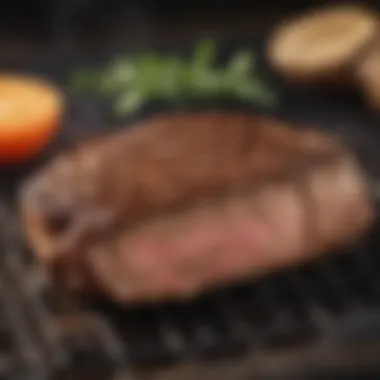
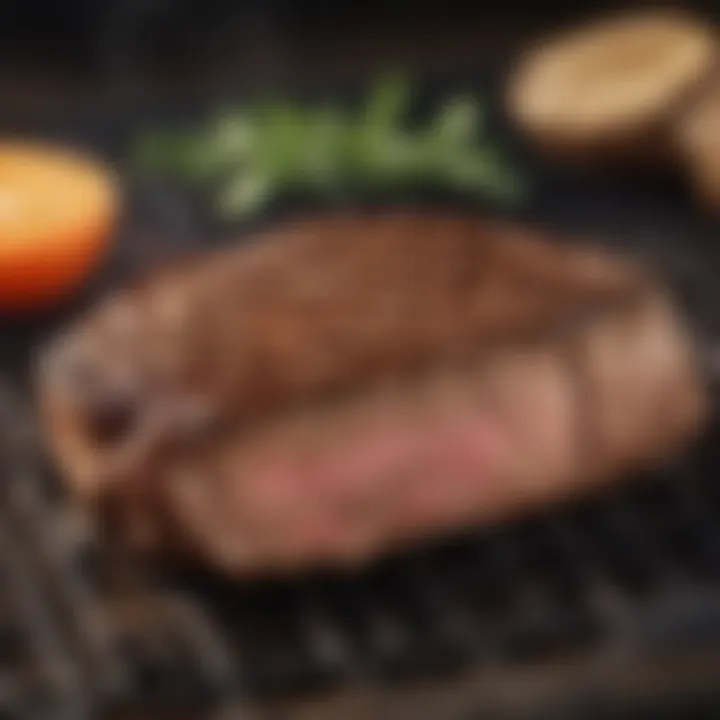
Intro
Grilling steak is a cherished tradition for many, but achieving the right temperature can often be a challenge. Charcoal grilling offers a unique flavor that gas grills may not replicate. However, without precise temperature control, the beauty of a well-cooked steak can be lost. This guide will provide an in-depth understanding of how to master grilling steak on a charcoal grill, addressing key elements like ideal temperature ranges, techniques for searing, and the importance of resting the meat after grilling.
By knowing the nuances of steak temperatures, both new and seasoned grillers can enhance their skills. Each cut of steak has its own ideal temperatures for cooking. If you understand these specifics, it will not only improve your cooking but also elevate the flavors of your dishes.
The science behind heat transfer plays a crucial role in cooking. Understanding how heat interacts with steak allows you to make informed decisions while grilling. This guide will explore these principles alongside practical techniques to ensure that your next steak is consistently cooked to perfection.
Understanding Charcoal Grilling
Charcoal grilling is a fundamental aspect of outdoor cooking that brings unique flavors and textures to food. Understanding this process helps cooks develop skills that lead to perfectly grilled steaks. When you know how charcoal works, you can control the heat, which is crucial for achieving the desired doneness in steak.
The charcoal grill process involves burning charcoal briquettes or lump charcoal. This heat source influences not just cooking time but also flavor development. Charcoal often infuses a smoky taste that enhances the overall steak experience. This article emphasizes the importance of mastering charcoal grilling, as it contributes considerably to the art of preparing steak.
The Charcoal Grill Process
It begins with igniting the charcoal. The heat generated will reach varying temperatures, depending on how you set up the grill. The grill's cover plays an essential role, too, as it helps retain heat while cooking. Knowing how to manipulate the airflow also influences flame intensity. More intake allows for higher temperatures, which is important for achieving a good sear. Conversely, reducing airflow will lower the temperature for more gradual cooking.
Types of Charcoal
Effective charcoal grilling relies on the type of charcoal chosen. Two primary types exist, each with distinct characteristics that affect the grilling experience.
Standard Briquettes
Standard briquettes are widely used in grilling. They are consistent in shape and size, making it easy to estimate the time they will burn. Their uniformity allows for predictable temperature management. They are often treated with additives that help them ignite easily, ensuring a quick start to cooking.
However, these additives can alter the flavor profile of food which might not be desired by purists. They can also contain chemicals that create ash, needing regular cleaning. Nevertheless, the ease and reliability of briquettes make them a popular choice among many grillers.
Natural Lump Charcoal
Natural lump charcoal is another option and is made from pure wood. Its production process involves burning wood in the absence of oxygen, resulting in high heat output and great flavor. Unlike briquettes, natural lump charcoal has an earthy flavor which infuses meats nicely, enhancing the overall taste.
On the downside, lump charcoal burns faster and can result in less consistent heat. This characteristic requires the cook to pay closer attention to temperature control during grilling. Nonetheless, many find the rich flavor payoff justifies the extra effort required.
Setting Up the Grill
Setting up the grill correctly is vital for effective charcoal grilling. The arrangement can significantly influence cooking results. Here we consider two important methods: Direct Heat vs. Indirect Heat, and Creating Fire Zones.
Direct Heat vs. Indirect Heat
Direct heat involves placing food directly over the lit charcoal. This technique is perfect for searing steaks as it creates the intense temperature characterized by great browning and crust formation. Direct heat is essential to lock in juices and flavor. However, it necessitates careful attention to prevent burning.
Indirect heat, on the other hand, is where food is placed beside the lit coal, not directly over it. This method allows for slower cooking, beneficial for thicker cuts or when using marinades. It can lead to more even cooking and tenderness, especially in larger steaks.
Creating Fire Zones
Creating fire zones within the grill allows for versatility. By having a hotter zone for searing and a cooler one for finishing the steak, grillers can manage doneness effectively. This setup allows a cook to start the steak over direct heat and then transfer it to indirect heat, achieving perfect results without losing moisture.
Understanding the elements of charcoal grilling sets the stage for mastering steak cooking. The ability to control heat and utilize the types of charcoal significantly enhances the grilling experience.
Choosing the Right Steak
Choosing the right steak is crucial for mastering the art of charcoal grilling. Different cuts have unique characteristics that influence flavor, tenderness, and how they respond to heat. Understanding these aspects not only aids in selecting the ideal steak but also contributes to achieving the desired doneness and taste. A well-chosen steak can elevate a simple meal into a culinary experience, enhancing both the process and the outcome of grilling.
Popular Cuts of Steak
Ribeye
Ribeye is known for its rich marbling and tenderness. This cut is a favoured choice among steak enthusiasts due to its balanced flavor and juiciness. The marbled fat within the meat ensures a delectable taste and helps maintain moisture during grilling. However, the richness of ribeye can be overwhelming for some, and it generally cooks quicker than leaner cuts, necessitating careful temperature management.
T-Bone
The T-Bone steak features a combination of two cuts: the tenderloin and the strip. This juxtaposition offers a delightful contrast between the rich flavor of the strip and the tenderness of the tenderloin. It is often seen as a symbol of a great steak experience. One downside is that its size can make it difficult to handle and cook evenly on a grill, requiring attention to both sides for consistent doneness.
Sirloin
Sirloin is a versatile cut that provides a good balance of flavor and tenderness. It is generally more affordable than the ribeye or T-Bone, making it accessible for many cooks. While not as fatty, sirloin can still be quite flavorful when cooked properly. Its major advantage is adaptability, lending itself well to various marinades and seasonings. Although it might not be the most tender option, its flavor can often compensate for this downside.
Filet Mignon
Filet Mignon is celebrated for its exceptional tenderness and subtle flavor. Cut from the tenderloin, this steak is often considered a luxury choice. Its low-fat content means it cooks faster and doesn't require much seasoning to appreciate its natural taste. However, some might find it lacking in richness compared to fattier cuts like ribeye. This cut is perfect for those who prioritize tenderness over bold flavor.

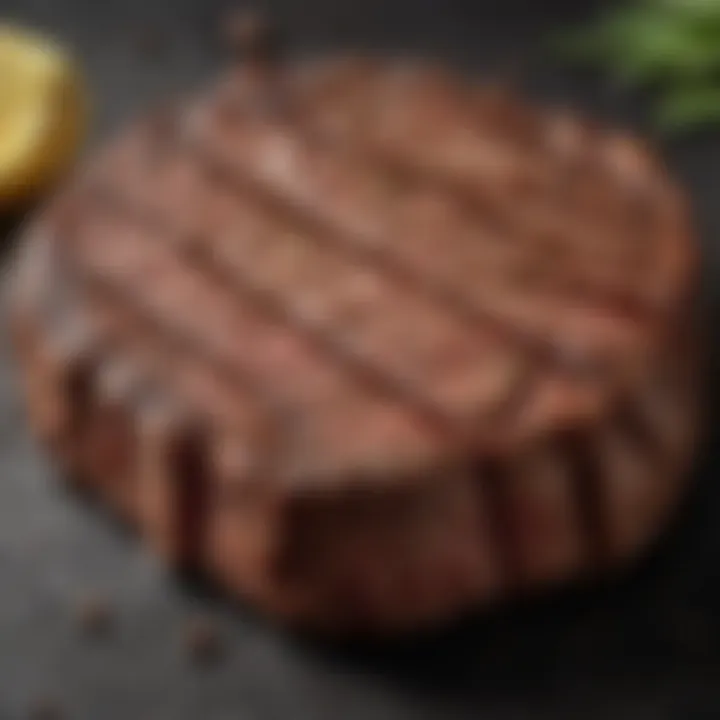
Factors to Consider
Thickness
The thickness of the steak significantly affects cooking times and temperature. Thicker cuts can retain more moisture and are forgiving if slightly overcooked. However, they require a longer cooking time to reach the desired doneness, making them suitable for low-and-slow grilling methods. On the other hand, thinner steaks cook quickly, so they demand careful attention to prevent overcooking, which can result in a dry texture.
Grade of Meat
The grade of meat is a vital factor in determining the quality and flavor of the steak. Higher grades, such as USDA Prime, contain more intramuscular fat, leading to better flavor and tenderness. Understanding the grading system helps in making an informed choice. While premium cuts are more expensive, their superior taste can justify the price for special occasions.
Marbling
Marbling refers to the fat interspersed within the muscle tissue. This characteristic directly impacts flavor, juiciness, and tenderness. Steaks with abundant marbling are typically more flavorful and can better withstand the high heat of a charcoal grill. Conversely, lean cuts have less fat, requiring careful cooking to avoid toughness. Striking a balance between marbling and personal preference enhances the grilling experience.
Ideal Temperature Ranges for Steak
Understanding the ideal temperature for cooking steak is crucial for achieving desired doneness and flavor. It affects the texture and juiciness of the meat. Different cuts of steak require precise temperatures to ensure they are cooked just right, allowing the natural flavors to shine. Balancing these factors can transform a good steak into an exceptional one.
Understanding Meat Temperatures
Meat temperatures are measured using a meat thermometer, providing accurate data on doneness levels. Each temperature range correlates with a specific cooking point:
- Rare: 120-125°F (49-52°C)
- Medium Rare: 130-135°F (54-57°C)
- Medium: 140-145°F (60-63°C)
- Medium Well: 150-155°F (65-68°C)
- Well Done: 160°F (71°C) and above
Listening to these numbers is significant because they align with the science of cooking, helping to achieve the right texture and flavor.
Temperature Guidelines
Medium Rare
Medium rare is often considered the ideal steak doneness by many chefs. This temperature ensures that the steak remains juicy while achieving a warm red center. Cooked to about 135°F (57°C), it retains more moisture compared to higher doneness levels. This characteristic keeps the meat tender and flavorful, making it a preferred choice for steak lovers.
Medium
Medium steak reaches a temperature of about 145°F (63°C). The center is a warm pink, appealing to those who want a balance between juiciness and firmness. This doneness tends to be popular among diners who enjoy a slight chew without the toughness that comes from undercooking or overcooking. Though some may argue it loses some flavor compared to medium rare, it remains a common choice in many steak houses.
Medium Well
Medium well steak is cooked to about 155°F (68°C). It displays only a hint of pink in the center, appealing to people who prefer a firmer texture. While it can still hold some juice, it is close to being fully cooked. The flavor becomes a bit less intense at this point, but many appreciate its consistency and slightly crisp outer texture.
Well Done
Well done steak is cooked to a minimum of 160°F (71°C). There is no pink in this steak, making it a preferred choice for those who like meat fully cooked. However, this doneness can lead to dryness and a lack of flavors, especially in tender cuts. Paying close attention to the time and technique is necessary to minimize these drawbacks and create an enjoyable dining experience.
Epilogue
Grilling steak is an art that combines knowledge and technique. By mastering the ideal temperature ranges, anyone can elevate their grilling game. Monitor the internal temperature carefully and adjust cooking methods based on the thickness and cut of steak. With practice, understanding these temperature nuances will lead to better tasting and more satisfying meals.
Techniques for Grilling Steak
Understanding the right techniques for grilling steak is crucial for achieving an impressive meal. Each step in the grilling process impacts the overall flavor and texture of the steak. By mastering grilling techniques, one can enhance the satisfaction of the dining experience. Key elements include preparation, cooking methods, and the essential use of tools like meat thermometers. This section dissects these techniques to provide a clearer understanding of how to grill steak perfectly each time.
Preparing the Steak
Marinades and Seasonings
Marinades and seasonings significantly influence the flavor profile of grilled steak. By marinating, you introduce moisture and infuse the meat with various flavors. Most marinades consist of components like acid, oil, and seasonings. A common choice would be vinegar paired with herbs and spices. This mixture tenderizes the meat while adding zest.
One key benefit of using marinades is that they allow for creativity. You can tailor the flavor to your preference. While over-marinating can lead to mushy textures, a few hours can yield excellent results. Finding the right balance is essential, making this technique both popular and effective.
Bringing to Room Temperature
Bringing the steak to room temperature may seem small but holds importance in cooking. This process reduces the cooking time and promotes even doneness. When cold steak hits the hot grill, the outside may cook faster than the inside, leaving a cold center. The key characteristic here is simplicity. Allow the steak to sit for about 30 minutes before grilling. This is advantageous as it simplifies the cooking process. However, forgetting this step could yield uneven results.
Grilling Methods
Searing
Searing is an important technique for creating that savory crust on steak. The high heat associates with the Maillard reaction, caramelizing the exterior and enhancing the flavor. Searing not only tastes great but contributes to a visually appealing presentation. Starting with a hot grill is crucial. Getting that initial sear helps lock in juices. While some may say that searing can cook the steak too quickly, this method, when used carefully, usually leads to a flavorful outcome.
Flipping Techniques
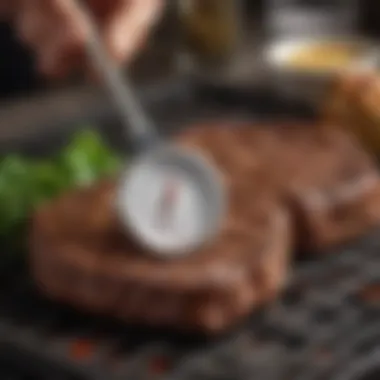
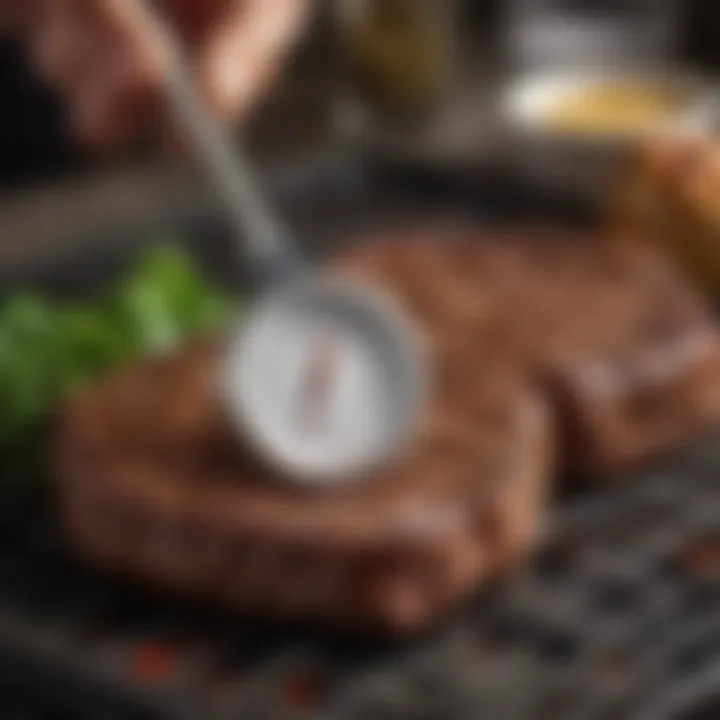
Flipping techniques can change the final texture of the steak. The common advice is to flip the steak just once. This allows for even cooking while preventing loss of juices. However, many cooks find that flipping multiple times can promote a uniform doneness. The unique feature of this method lies in individual preference. While some favor a hands-off approach while others opt for more interaction with the grill, understanding your steak will guide your choice. A thoughtful flip can enhance the cooking experience.
Using a Meat Thermometer
The use of a meat thermometer cannot be overstated. This tool is beneficial to ensure precise cooking and prevents overcooking or undercooking. Many cooks rely on experience, yet a thermometer offers an accurate temperature reading. It is essential for achieving specific doneness levels. The advantage here is clarity and precision. The drawback might involve a slight adjustment to incorporate into your routine, but the results make it worthwhile.
"A meat thermometer helps demystify cooking temperatures, turning grilling from an art into a science."
The Science of Heat Transfer
Understanding heat transfer is an essential aspect of mastering charcoal grilling. The way heat moves from the grill to the steak plays a significant role in determining the final outcome of your cooking experience. This section delves into the types of heat transfer and how you can harness this knowledge to improve your grilling techniques.
Conductive Heat vs. Radiant Heat
Heat transfer occurs primarily in two forms when grilling: conductive and radiant heat. Conductive heat is the transfer of heat from the hot grill grate directly to the meat. This is vital for the initial searing process. The more contact your steak has with the grill, the better the sear. However, over time, too much conductive heat can lead to uneven cooking if not monitored properly.
Radiant heat refers to the heat emitted from the glowing charcoal or the hot surfaces of the grill. It radiates towards the steak, cooking it more slowly. This is particularly important when you are utilizing indirect heat zones. The combination of both conductive and radiant heat allows for better control over the cooking process. Knowing when to rely on each method can enhance your results significantly.
Impact of Charcoal on Cooking Times
The type and amount of charcoal you use in your grill can dramatically affect cooking times. Natural lump charcoal produces a higher temperature than standard briquettes. This difference in temperature influences how quickly your steak cooks.
When using natural lump charcoal, it ignites faster and burns at higher temperatures, which can effectively create a robust sear on your steak. However, it also tends to burn out quicker. It requires more attention during the grilling process to maintain consistent heat.
On the other hand, standard briquettes offer a more stable and prolonged heat. They are ideal for longer cooking times, which benefits larger cuts or when using indirect heat. However, they may need additional time to reach optimal temperature levels.
Considerations for cooking time and charcoal choice:
- Flare-ups can occur more frequently with lump charcoal, requiring a more hands-on approach.
- Using a higher quantity of briquettes may help stabilize heat over extended periods.
- Always account for pre-heating your grill to ensure the best heat distribution.
By understanding these heat dynamics and how charcoal influences your cooking, you can refine your grilling techniques, resulting in perfectly cooked steak every time.
Resting the Steak
Resting steak is a crucial step often overlooked by many in the grilling process. The concept of resting relates to the redistribution of juices within the meat. When a steak is cooked, the fibers within the meat contract, pushing juices toward the center. If one cuts into the steak immediately after cooking, these juices will escape, leading to a dry texture. Allowing the steak to rest helps the meat reabsorb these flavorful juices, ensuring every bite is moist and savory. Furthermore, resting also allows the temperature to even out, enhancing the overall eating experience.
Importance of Resting
The significance of resting steak cannot be overstated. First, it plays a vital role in both flavor and texture. A properly rested steak is more tender because the juices have a chance to redistribute, providing a more consistent flavor throughout the cut. Additionally, the carryover cooking effect means that the internal temperature may rise slightly during the resting phase, potentially bringing it closer to the desired doneness, especially if it was cooked to the lower end of a temperature range.
It is essential to consider factors like the thickness of the steak and the cooking method when determining resting time. A thicker cut will require a longer resting period compared to thinner ones. Moreover, the choice of a warm surface or covering the steak with aluminum foil can help maintain warmth during this resting phase, preventing it from cooling down too much.
How Long to Rest
Determining how long to rest steak can be straightforward. A general guideline suggests resting time needs to be about one minute for every 100 grams of meat. For instance, a typical ribeye steak may benefit from resting for approximately five to ten minutes. When it comes to larger cuts, such as a whole beef tenderloin, resting may require as much as 15 to 20 minutes.
While waiting, one can creatively prepare side dishes or sauces. A moment spent waiting for the steak to rest can be put to good use, ensuring that the meal is ready to serve. However, it is important not to rush through the resting process, as this is where the magic happens and transforms the grilled steak into a delightful culinary experience.
Remember, patience during resting leads to perfection on the plate.
Common Mistakes in Grilling Steak
When it comes to grilling steak, avoiding common mistakes is crucial to achieving that desired flavor and texture. This section highlights key errors that grillers often make and emphasizes the importance of awareness in preventing them. Grilling steak is both an art and a science. Understanding these mistakes can lead to better outcomes and a more enjoyable cooking experience.
Under Seasoning
One of the most frequent mistakes people make is under seasoning their steak. Many believe that the natural flavor of high-quality cuts is sufficient, but seasoning enhances that flavor. Using only salt and pepper can dramatically change the taste.
It is essential to apply seasoning generously to all sides of the steak. For maximum flavor, consider:
- Using kosher salt or sea salt, as they dissolve well and help to form a crust.
- Experimenting with other spices like garlic powder, onion powder, or even smoked paprika.
- Allowing the steak to rest after seasoning and before grilling; this helps flavors infuse better.
Overcooking
Overcooking steak is a pervasive mistake that can turn a perfect cut into a dry and chewy piece of meat. Many cooks rely solely on cooking time rather than understanding the meat’s doneness.
To avoid overcooking:
- Familiarize yourself with the proper temperature range for each doneness level.
- Use a meat thermometer for accuracy; steak continues to cook slightly after it is taken off the grill.
- Keep a close eye during the grilling process; different grills can produce varying heat levels.
As a rule of thumb, remember: a well-done steak can have quite a different texture than a medium steak; aim for a tender bite.
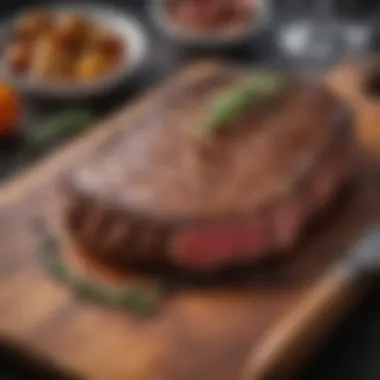

Not Monitoring Temperature
Failing to monitor the meat temperature is a significant oversight that can lead to unsatisfactory results. Understanding internal temperature is crucial for ensuring food safety and achieving the desired doneness.
To effectively monitor temperature:
- Use a reliable meat thermometer; models like the Thermapen or instant-read thermometers can provide quick readings.
- Know the target temperatures for each level of doneness:
- If using the feel test instead of a thermometer, be aware this method varies by individual experience.
- Medium Rare: 130-135°F
- Medium: 140-145°F
- Medium Well: 150-155°F
- Well Done: 160°F and above
"Knowing the internal temperature of your steak is essential. It's science more than guesswork."
By taking these errors into account, grillers can significantly enhance the quality of their steak preparation. The path to masterful grilling involves learning from these common mistakes and implementing practical solutions.
Enhancing Flavor Post-Cooking
After cooking a steak to perfection on a charcoal grill, the flavor can be significantly elevated through post-cooking techniques. The right finishing techniques allow one to enhance the natural taste of the steak and introduce new flavors that complement the meat. This aspect of grilling is essential as it not only adds depth but also maximizes enjoyment of the meal.
Finishing Techniques
Adding Compound Butter
Adding compound butter is a highly effective method to elevate the flavor of grilled steak. This type of butter is blended with various ingredients such as herbs, garlic, or citrus zest. The key characteristic of compound butter lies in its simplicity and versatility; it melds seamlessly into the warm steak, creating a rich, flavorful experience. It is a beneficial choice for those seeking to impart a distinctive flavor profile without overwhelming the dish.
One unique feature of compound butter is that it can be customized to match personal preferences or seasonal ingredients. This allows cooks to experiment and find the perfect combination that enhances their particular steak cut. However, one must be cautious about the quantity used, as too much butter can mask the natural flavors of the meat.
Finishing Salt
Finishing salt is another tool in the cook's arsenal for enhancing steak flavor. This salt, often flaky or coarse, is sprinkled on the steak just before serving. The key characteristic of finishing salt is its texture which contrasts with the tender meat, adding a pleasant crunch that appeals to the palate. It is a popular choice because it often brings out the umami notes in the steak, enriching the overall flavor experience.
One unique feature of finishing salt is the variety available, from sea salt to fleur de sel. Each type can add different nuances to the taste of the steak. The advantage of using finishing salt is that it requires minimal effort while delivering maximum impact. However, overusing it could lead to a salty dish, so moderation is key.
Pairing with Sides
Best Side Dishes for Steak
Choosing the right side dishes is crucial in complementing grilled steak. Classic pairings like grilled vegetables, creamy mashed potatoes, or fresh salads enhance the overall meal experience. The characteristic of these side dishes is their ability to balance the rich, hearty nature of the steak. They are beneficial choices as they provide texture and variety, making the plate visually appealing.
Unique features of side dishes for steak can include seasonal ingredients. For instance, using asparagus in the spring or root vegetables in the winter. The advantage of fresh sides lies in their ability to enhance the main course without overshadowing it. However, one must ensure that the flavors of the sides align with the chosen steak to create a harmonious meal.
Wine Pairing Guide
A well-selected wine can elevate a steak dinner to a whole other level. The key characteristic of properly pairing wine with steak is understanding the flavor profile of both the meat and the wine. Full-bodied red wines like Cabernet Sauvignon or Malbec traditionally pair well, complementing the robust flavors of grilled steak. This is a beneficial choice for enhancing the dining experience through complementary flavors.
One unique aspect of wine pairing is the importance of balancing acidity with richness. A higher acidity wine can cut through the fat, enhancing taste and making each bite more enjoyable. The advantage of thoughtful wine selection is the ability to create an impressive presentation at dinner. However, careful consideration must be given to personal preferences, as taste can be subjective.
"The way we finish our food can leave a lasting impression on our guests – every detail matters!"
In summary, implementing effective post-cooking techniques like adding compound butter or utilizing finishing salt, along with thoughtful side dishes and wine pairings, enhance the overall enjoyment of grilled steak. These finishing touches play a significant role and should be considered by anyone looking to master their charcoal grilling skills.
Closure
The conclusion serves a critical function in understanding the nuances of grilling steak over charcoal. It synthesizes the essential elements discussed throughout the article, reinforcing the importance of temperature management, preparation methods, and post-cooking techniques. Knowing ideal temperatures for different cuts of steak can significantly influence the quality of the final dish. For example, a perfectly cooked medium-rare ribeye presents as juicy and tender, while an overcooked piece becomes dry. This makes temperature awareness paramount in every grilling session.
In addition, the significance of proper seasoning and cooking methods cannot be overstated. Seasoning enhances the flavors, while various grilling techniques like searing impact the meat’s texture. Another crucial topic is the resting phase after cooking. Steaks should rest to allow redistribution of juices, which is a common oversight among even seasoned cooks.
Therefore, reevaluating approaches towards grilling can lead to improvements in flavor and presentation. The benefits extend beyond mere taste; enhancing these elements fosters greater enjoyment and satisfaction with the culinary process.
Summary of Best Practices
- Control Temperature
- Prepare Thoughtfully
- Sear Effectively
- Rest After Cooking
- Use a meat thermometer to monitor internal temperatures.
- Familiarize yourself with specific temperature ranges for doneness.
- Season generously before cooking.
- Bring steak to room temperature before grilling.
- Start on high heat to develop crust.
- Flip steak at appropriate intervals.
- Allow steak to rest for 5-10 minutes before slicing.
- This helps retain juices and enhance flavor.
Understanding and applying these practices firmly establishes a foundation for mastering charcoal-grilled steak.
Encouragement for Practice
Grilling steak perfectly requires practice. While it may feel overwhelming at first, every attempt builds confidence and skill. Start with familiar cuts and observe how different techniques influence results. Maintaining a cooking journal can help track what works best and what can be adjusted.
Don’t shy away from experimenting with various flavors, temperatures, and resting times. Each grill session presents an opportunity to learn. Engage with resources such as Wikipedia, Britannica, or communities on Reddit for shared insights and discussions.
As grilling becomes a more natural experience, you will refine your techiniques and unveil the pleasures of charcoal cooking. Unused potential exists until tapped; embrace each grill session with curiosity.







